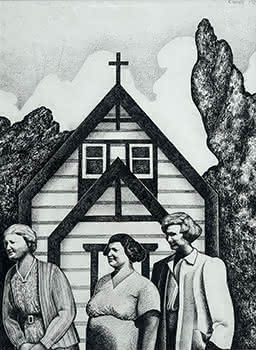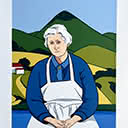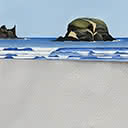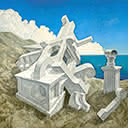Relatives at the Maketu Church
36 x 26 cm
est. $20,000 - 30,000
Made in 1972, this conté drawing on paper was the basis for an edition of 50 silk screen prints exhibited at the Barry Lett Galleries in Auckland in December 1974 which sold for $30 each. The setting is the same small town on the Bay of Plenty coast as Robin White's iconic fish and chip shop painting which is in the collection of the Auckland Art Gallery Toi o Tāmaki. Maketu was the landing place of the Arawa canoe and is named after an ancient kumara pit in Hawaiki, where the sea journeys began. The three women relatives are superimposed in front of the historic St Peter's Catholic Church in Maketu, symbolic of the arrival of settler culture in Aotearoa.
St Peter's was designed by Father James Russell Madan who served with the Mill Hill Missionaries at Matata in 1886. The church was built by the local iwi of Maketu and was described in the Bay of Plenty Times in 1888 as an ingenious structure: There is not a nail in the building except in the roof, the timbers being put together by bolts and screws. St Peter's also features in Easter, Maketu (1971) a screenprint made by the artist in an edition of 25 and sold at both Barry Lett Galleries in Auckland and Peter McLeavey Gallery in Wellington for $12. Robin White has shown the three women like a holy trinity in front of the simple entrance porch, framed by the barge boards of the steeply pitched Victorian gothic corrugated iron roof. Then as now, the church's weatherboards were coated with white paint and its roof and joinery were painted red, making it resemble a wharenui or meeting house. The artist's father Albert Tikitū White (1894-1976) was descended from a Ngāti Awa woman, Mere Te Uia, and met his wife-to-be Florence Miriam Dunlop (1904- 1979) when he moved to the Bay of Plenty to find work and boarded with her family.
Writing about this work in his Art International article on Young Contemporary New Zealand Realists in 1973, Patrick Hutchings emphasised the way in which the cypress tree on the right rears up like a flame, dominating the figures and casting a pall on the mood: the melancholy little church and landscape impose their psychological tone on the three women, who are smiling, bravely but cheerfully … a seen landscape has called from the artist a memorial picture, with faces from the family album; a dream, a vision of the past, expressed in the precise tones of a pragmatic present.
Essay by - Linda Tyler





